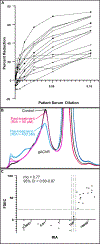Fluorescence-detection size-exclusion chromatography specifically detects autoantibodies targeting the ganglionic acetylcholine receptor in patients with autoimmune autonomic ganglionopathy
- PMID: 39277987
- PMCID: PMC12219111
- DOI: 10.1016/j.jneuroim.2024.578454
Fluorescence-detection size-exclusion chromatography specifically detects autoantibodies targeting the ganglionic acetylcholine receptor in patients with autoimmune autonomic ganglionopathy
Abstract
Autoimmune autonomic ganglionopathy (AAG) is a rare disease wherein autoantibodies target the ganglionic acetylcholine receptor (gAChR). Current diagnosis in the United States depends upon clinical symptoms and positive autoantibody detection using a radioimmunoprecipitation assay (RIA). Here we offer a proof-of-principle study on an alternative method, fluorescence-detection size-exclusion-chromatography (FSEC). We show FSEC can detect autoantibodies against gAChR from patient sera but not healthy controls or samples from other autoimmune diseases. We compare FSEC to RIA and find good correlation. We discuss potential advantages of using FSEC as an alternative or as a first-step diagnostic prior to pursuing existing methodologies.
Keywords: Acetylcholine receptor; Autonomic; Detection; FSEC; Membrane protein; Neuronal.
Copyright © 2024 The Authors. Published by Elsevier B.V. All rights reserved.
Conflict of interest statement
Declaration of competing interest SV has received compensation as a consultant for argenx, Alterity, Amneal, Catalyst and LabCorp and has received research support from Quest Diagnostics (through a licensing contract). NM has received compensation from Genentech, Inc. as a member of the steering committee for CHIMES and is a co-founder of GenrAb, Inc.
Figures




References
-
- BALESTRA B, MORETTI M, LONGHI R, MANTEGAZZA R, CLEMENTI F & GOTTI C 2000. Antibodies against neuronal nicotinic receptor subtypes in neurological disorders. J Neuroimmunol, 102, 89–97. - PubMed
-
- DRACHMAN DB, ADAMS RN, JOSIFEK LF & SELF SG 1982. Functional activities of autoantibodies to acetylcholine receptors and the clinical severity of myasthenia gravis. N Engl J Med, 307, 769–75. - PubMed
Publication types
MeSH terms
Substances
Grants and funding
LinkOut - more resources
Full Text Sources

